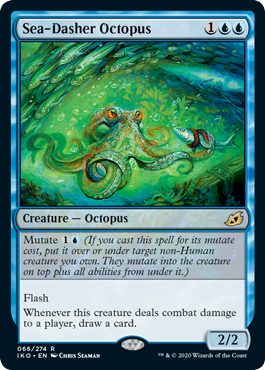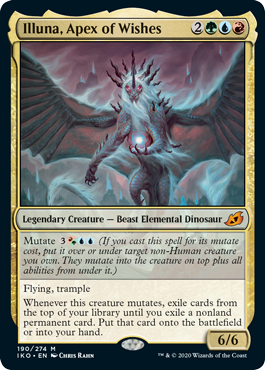More Than Meets the Ikoria
Hello, everyone, and welcome to my first Ikoria: Lair of the Behemoths preview article. This set has a cool design story that I've been dying to tell you all, so I'm happy it's finally time to do so. I'm going to introduce you to the Ikoria Vision Design team, explain how we made our main mechanic (mutate), and show off a cool preview card. I hope that encourages you to keep reading.
Meet the Monster Makers
Andrew Veen

Andrew got his start in R&D doing design work on game called Kaijudo. We make a trading card game for the Japanese market called Duel Masters, and Kaijudo was our attempt to bring it to the United States. Andrew then transitioned from designing Kaijudo to designing Duel Masters. We borrowed him from time to time to do Magic design (he was on the design team for Shadows over Innistrad and the development teams for Guilds of Ravnica and Theros Beyond Death, as well as working on various supplemental products), and eventually he moved over fulltime to doing Magic design. Andrew was my "strong second" on this set, meaning he oversaw handling of the file and did a lot of the larger organizational elements of the vision design (scheduling meetings, sending out homework assignments, etc.).
Corey Bowen

Corey started as a summer college intern. We liked him so much that after he graduated, we gave him a fulltime job. Corey has worked on numerous design teams and currently has the responsibility of designing many of the Commander decks that are forthcoming, including the ones for Ikoria. I like to get new designers on my Vision Design team as they're full of new ideas, and Corey is no exception.
Dave Humpherys

I first met Dave Humpherys on the Pro Tour back in my feature match–judging days. Dave would go on to become a Pro Tour Hall of Famer. He then went on to work in game design at other companies and eventually made his way to Wizards. Dave has worked on numerous design teams and has led or co-led a lot of development teams and Set Design teams (Avacyn Restored, Journey into Nyx, Conspiracy, Fate Reforged, Dragons of Tarkir, Shadows over Innistrad, Amonkhet, Hour of Devastation, Unstable, Dominaria, and War of the Spark). Dave is the set design lead for Ikoria, and he likes being on the Vision Design team so he can help shape the vision as well as better understand it. Having Dave on a Vision Design team always makes it better.
Peter Lee

Peter is an amazing tabletop game designer who worked on both the Dungeons & Dragons miniature line as well as the roleplaying game before coming over to the Magic team. Peter was my "strong second" on both War of the Spark and Throne of Eldraine. He's a very inventive card designer (he designed Gingerbrute, my favorite card in Throne of Eldraine) and didn't disappoint on the Ikoria Vision Design team.
Mark Rosewater (lead)

And then there's me. You know me. Not much new to say.
Just Smashing
When we first penciled Cricket, Ikoria's codename, on our master plan (we used to call it a "five-year plan," which I joked was a "seven-year plan" as I always added a few extra things at the end of it), it was supposed to be our return to Theros. You see, both Archery and Baseball were going to be set on Eldraine. The idea was that we would meet the world in the first set and then have our heroes, Rowan and Will, venture into the deep, dark, scary forest in the second set. It was decided early in Baseball's vision design to stick to just one set on Eldraine and move up Theros from Cricket to Baseball. That meant that we had a hole we needed fill.
Aaron Forsythe, my boss, asked me to look ahead to the many worlds we'd been planning for the following years to see if there was something we could pull earlier to fill the Cricket slot. There was a number of criteria I had to follow:
- As it was being sandwiched between a return to Theros and a return to Zendikar, it was important that it was a new world.
- It had to fit mechanically with the worlds around it, meaning it didn't step on their toes while also being somewhat synergistic.
- It needed to be tonally different. The reason players don't get bored of Magic is because it keeps changing. It was important for the world not to feel too close to those around it.
- It had to be something that I had confidence we could mechanically execute on.
We had a lot of interesting world ideas (most of which you'll be seeing in the next few years), but one plane stood out to me. We had dubbed it Monster World. It would be a world that tapped into the trope space of monster movies (things like Godzilla). The world would have giant monsters as well as the humans that interact with them. I was very excited by the idea and felt it would be something the players would enjoy. The big question: how do we execute on it mechanically? I recognized it would be a challenge, but I do so love a challenge (and I had a few ideas), so I told Aaron that I thought we should do Monster World. It was approved within a month.
A Monster Challenge
Here was the sticking point of the design. How could we stay true to the trope space we were working in while making a set that was still fun to play in both Limited and Constructed? The first place to look would be Rise of the Eldrazi as it had many of the same issues. It was a set that revolved around three giant "monsters" (aka the Eldrazi). How did they handle this issue? They took a path we call "Battlecruiser Magic" where you force people to opt into playing large creatures by removing most of the other options. The environment is slower, aggro strategies are neutered, and ramp is added to help you get out giant creatures.
The problem with this path is that by every metric we had, save one (which I'll get to in a moment), Rise of the Eldrazi was not popular with the players. Players bought less, played less, and ranked it worse in market research. And this had come on the heels of two popular sets that were both set on Zendikar. The one group that was the exception was the enfranchised drafting crowd. The fact that normal strategies didn't work and forced you to rethink how you played made the Draft format very popular with them. The non-enfranchised crowd, in contrast, played once or twice, didn't get was going on because the things they normally did didn't work, and lost without understanding why, so they stopped playing as it wasn't fun for them.
The good news about having something that didn't work is that you can take lessons from it. So, my team and I took a little time understanding what went wrong. First up, the giant monster track had to be something you could opt into but wasn't something you had to do. If you wanted to play a more normal game, that had to be an option. Second, we needed to fill our whole curve, meaning we had to find ways to make monsters of all sizes. Luckily, the source material helped us out a bit there. Third, the set didn't give you a lot of agency in what kind of monster you got. Was there a way to let the players have some input into their monster?
I should also point out that we did spend some time trying to understand what it is the enfranchised players liked about Rise of the Eldrazi so we could apply those lessons where possible when building the Draft environment.
All these lessons led us back to the source material. How could we make different sizes of monsters while also giving players a chance to customize their monster? The answer was evolution or mutation. One of the tropes of monster movies was that the monster usually doesn't start out gigantic. They tend to start out small, often cute. Then something happens which causes them to change in some way, most often getting bigger. Was there a way to capture that in gameplay?
That led us to a mechanic called champion, something we had done in Lorwyn.
Champion had been designed as a flavorful type of evolution. Card A becomes Card B, but to avoid things playing out the same every game, Card B could change from any card of a certain creature type (Faeries in the Mistbind Clique example above). Mechanically, this was executed by exiling a creature when the creature with champion enters the battlefield. Then, to offset the card disadvantage of the mechanic (it acted a lot like an Aura), you got the original creature back if the creature with champion left the battlefield. This was a noble attempt, but the mechanic didn't really connect with the players. The gameplay was functional but not exciting, and it lacked a flavor that made any sense. Again, could we learn from our mistake? It turns out we could, and in a pretty exciting way.

Monster Mash
If we could redo champion, how would we do it differently? I liked the idea that you had a card that changed a creature you had on the battlefield into something better. I was less fond that it always changed into the same thing. Was there some way to make the mutated creature different from casting to casting? This led us to the idea—what if what you mutated mattered? What if the creature you chose to mutate affected how it mutated?
A few months earlier, we had what we call a Hackathon, where R&D takes a week off from our normal work to tackle a design problem. The first Hackathon was looking for new supplemental sets and ended up creating Modern Masters and Jumpstart. The latest Hackathon had been at my request and was looking at future design space. The mini-team I led was "outside game components" where we explored things you could do if you made use of things beyond your deck. One suggestion was looking into punch-out technology. We had used it for Amonkhet, but a number of R&D members, including Dave Humpherys, felt there was a lot of future design potential in it.
One of the ideas in this space was keyword counters. Normally, we put +1/+1 or -1/-1 counters on creatures to change their stats, but what if we had the technology to put keywords permanently on a creature? We experimented with it a bit in the Hackathon and found it a deep design vein. Was there a way to use keyword counters to help achieve our goal of making what you mutated matter? It turns out there were three ways it could.
Before I begin with these examples, I want to note that mutate mutated a lot through both vision design and set design. What I'm explaining below is how mutate worked for a while. It's not how it works in the final product, which I will explain when I get there. I'm just trying to walk you through its evolution as a mechanic.
Use #1: Counters Mattering
In all our implementations of mutate, we said that the new creature was to be treated as if it was the old creature, which meant that any Auras, Equipment, or counters would stay on the creature. Thus, if you granted flying to a creature with a keyword counter and it got mutated, that flying counter would carry over to the new creature and it would also fly.
Use #2: Allowing Extra Mutations
We wanted the mutated creature to care about the creature it mutated, and we realized that keyword counters could help us. What if the mutated creature had an ability that also existed as a keyword counter? Could the mutating creature gain that ability? For example, I have a 3/3 with trample. I mutate it with a 5/5 creature. Because it had a keyword that also existed as a keyword counter (we called them "inheritable keywords"), the mutated creature would get a keyword counter with that ability. This allowed the mutating creature to have some of the abilities of the creature it mutated.
Use #3: Something to Mutate
Another thing we carried over from champion was the idea of a creature type being a limitation for mutation. Rather than call it out by name like champion, we made the restriction that it had to match at least one of your creature types. For flavor, we had assigned a main creature type per color. Then, when we started making multicolored cards, they got to be a combination of all creature types of its colors. White is Cat, black is Nightmare, and green is Beast, so a white-black-green creature would be a Cat Nightmare Beast.
For extra flavor, we decided to add one other allowance for mutation—if you shared a keyword, that would also allow you to mutate the creature. Let me explain. Let's assume you had a 4/4 Dinosaur Beast with vigilance. You could mutate a creature onto that creature if it was a Dinosaur, a Beast, or it had vigilance. This mattered with keyword counters because it would change what a creature could be mutated into. For instance. I have a 2/2 Elemental. I put a flying counter on it. Now, I could mutate it with a creature that was an Elemental or one that had flying.
The other big change we made from champion was that you weren't required to have the smaller creature to play the card. If you have the mana, you can just play a mutate creature. You're not obligated to mutate it. From a play design standpoint, this helps solve a lot of the problems champion cards had in Constructed play. That said, we did want you to mutate it, so we encouraged it in two ways.
First, we gave the mutate creature a mutate cost. Creatures are cheaper to play if you mutate them as it requires you covering up a creature. Second, most of the creatures have a mutate effect, that is, if you mutate them, they do something. This not only encouraged you to mutate your creatures but even to sometimes mutate a creature multiple times. When the dust settled, we accomplished what we had set out to make. It was a champion-like mechanic that fixed the mechanical and flavor issues while creating something new in that it made creatures that evolved as you mutated them.
I remember one of the first games we played with the mechanic. I was playing against Andrew, and it went something like this:
Me: I have a 3/3 with trample.
Andrew: Well, I have a 4/4 with vigilance.
Me: Now I have a 6/6 with trample and first strike.
Andrew: I doubt it can stop my 7/7 with vigilance and menace.
Me: Do you have an answer to my 9/9 with trample, first strike, and hexproof?
Andrew: Yes, my 12/12 with vigilance, menace, and flying.
The game was a constant one-upmanship as Andrew and I kept mutating our creatures into bigger and nastier versions. I like to talk about how there's a moment in a design where something happens, and you realize you've tapped into something awesome. Mutate had a long way to go, but this playtest showed that the germ of the idea was very exciting. It also had a neat impact on gameplay that at every level you had viable creatures. You didn't have to wait for the big creatures to come out. You played what you had on curve, and over time, they slowly mutate into the big creatures.
We fiddled a lot with the mechanic, but here's where it ended up when we handed it off for set design. A mutated creature could mutate any creature that shared a creature type or keyword with it. Then it gained any Auras, Equipment, or counters on the mutated creature. If the mutated creature had any inheritable keywords, it would gain keyword counters for those abilities. Finally, it would trigger the mutate effect (which I believe every mutate creature had at handoff).
Ready, Set, Design
Set Design would make a few big changes to mutate, some that simplified things, and some that made it a bit more complicated. All of which, though, took a fun mechanic and made it even more fun. Let's walk through them:
The limitation of what you could mutate went away.
In Vision Design's version, you had to match up a creature type or a keyword. The Set Design team decided that we didn't need that restriction and changed it so that any creature with mutate could mutate any other creature. Eventually, they would add the restriction of non-Human as Humans changing into monsters wasn't flavorful for the trope space we were in.
It now gained all abilities.
In Vision Design's version, the mutated creature only picked up the inheritable keywords, that is, the keywords that existed as a keyword counter. Set Design decided that it should just pick up everything. It was definitely more complicated and required extra attention to know what the mutated creature did, but it was very fun.
The mutated creature can go on top or bottom.
In Vision Design's version, the mutation always went on top of the creature it mutated. Set Design changed it so that you could choose to put the creature on top or bottom, thus allowing you to set what the power and toughness is as it has the power and toughness of the creature card on top.
With all that out of the way, let's finally show off my preview card. Click below to meet Sea-Dasher Octopus.
Click here to meet Sea-Dasher Octopus

Now that we have an actual card to look at, I'm going to run you through how the final version of mutate works. Let's assume you have a Storm Crow (a 1/2 creature with flying) on the battlefield with Sea-Dasher Octopus in your hand. For 1U, you can mutate the Storm Crow. If you do, you may put the Sea-Dasher Octopus on top or on bottom of the Storm Crow. If you put it on top, the creature is a 2/2. If you put it on bottom, it is a 1/2. Regardless, it has flying and "whenever this creature deals combat damage to a player, draw a card" (what R&D calls "curiosity"). Let's assume you make it a 2/2 by putting the Octopus on top. Then, you draw this card:

For either 3RUU or 3GUU (the mutate cost has a red-green hybrid mana in it), you can mutate this onto your Octopus. You can put it onto the top or the bottom of the pile. If you put it on top, the creature is a 6/6. If you put it on bottom, it would be a 2/2. Let's assume you put it on top. You now have a 6/6 with flying, trample, and "curiosity." Also, when you mutate, you get to exile cards from the top of your library until you exile a nonland permanent card which you get to put onto the battlefield or into your hand.
For the full explanation of how exactly mutate works, you can check out the Ikoria rules article here.
Mutate Is Enough
Mutate went through a long and winding design path, but we ended up with something that is novel, flavorful, and very fun. I can't wait to see what you all think of it once you get to play it. As always, I'm eager to hear your thoughts on today's column, mutate, or anything else about Ikoria: Lair of Behemoths. You can email me or contact me through any of my social media accounts (Twitter, Tumble, and Instagram).
Join me next week when I explore more of Ikoria's design, including a mechanic that's just as weird as mutate.
Until then, may you have fun making monsters.
#727: Theros Beyond Death Cards, Part 4
#727: Theros Beyond Death Cards, Part 4
29:24
This is the fourth part of a series (of five) of card-by-card design stories from Theros Beyond Death.
#728: Theros Beyond Death Cards, Part 5
#728: Theros Beyond Death Cards, Part 5
31:15
This is the fifth part of a series (of five) of card-by-card design stories from Theros Beyond Death.
- Episode 726 Blue-Red
- Episode 725 Theros Beyond Death Cards, Part 3
- Episode 724 Theros Beyond Death Cards, Part 2

